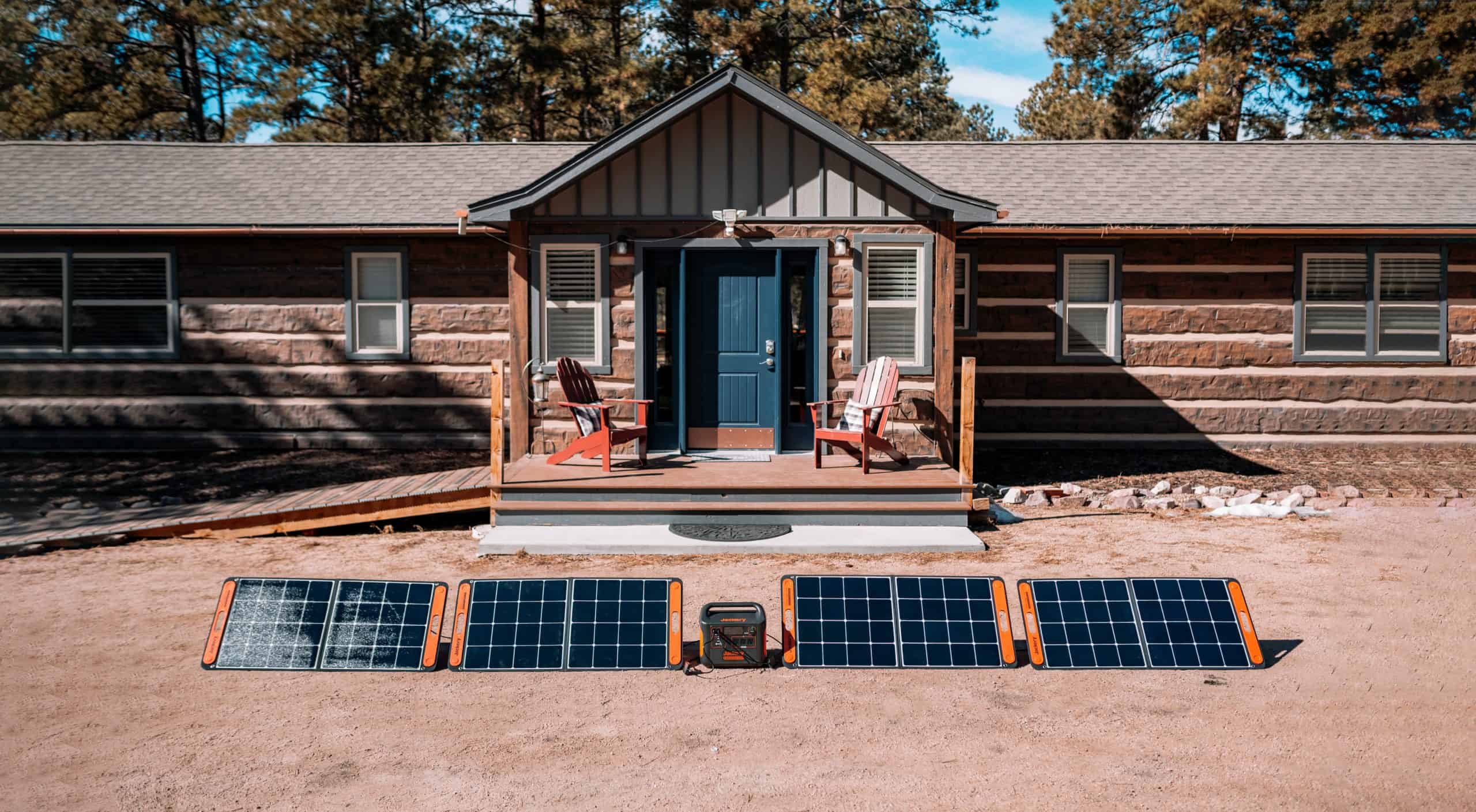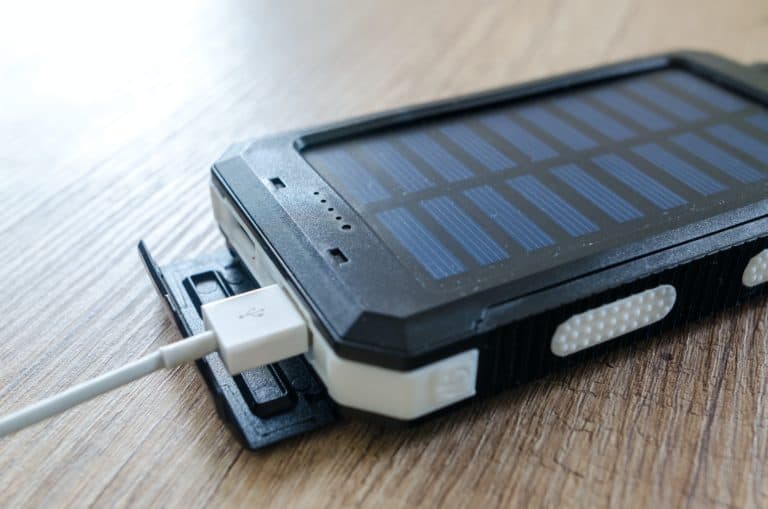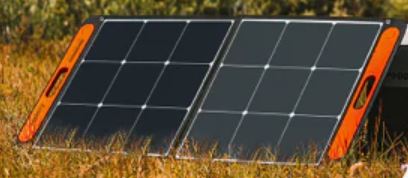Best solar panels for camping: The ultimate review
Are you looking to add to your outdoor gear while going green? Then look no further than the very best solar panels for camping.
With a reliable set of solar panels, you can turn your campsite into an all-natural oasis. This will allow you to enjoy nature without harming it.
With so many different kinds available on the market today, how do you decide on the best solar panels for camping that is best for you?
In this blog post, we’ll be taking a look at some of our top picks for the best solar panels for campers out there!
Best Overall: Anker 625 Solar Panel
Best Built-In Battery: BioLite SolarPanel 10+
Most Stable: Jackery SolarSaga 60
Best for Chaining: Goal Zero Nomad 20
1. Anker 625 solar panel
The Anker PowerPort Solar is a portable solar charger that delivers impressive charging capabilities with its high-efficiency monocrystalline cells.
This lightweight, foldable design makes it perfect for backpacking or car camping adventures.
The PowerPort Solar provides two USB ports, enabling you to power up multiple gadgets simultaneously in off-the-grid places.
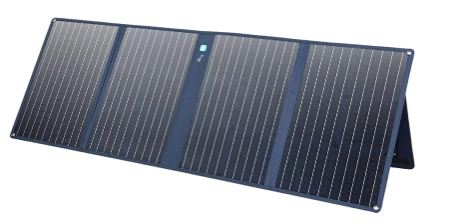
Pros:
- High efficiency: The solar panel can convert as much as 23% of sunlight into solar energy. This means that it can charge your solar generators even when the weather is cloudy.
- Portable: They are equipped with a flexible kickstand which you can adjust to achieve the optimal angle for solar charging. You can install them with little effort, Also, once you’re done, you can simply fold them up and take them along on your travels.
- Smart alignment with sunlight: With Anker’s exclusive Suncast technology, you can be sure to position the solar panel correctly to absorb direct sunlight and achieve optimal charging.
- PowerHouse compatible: You can use the Anker 625 soar panel with PowerHouse 521, 535, and 757 (available separately).
- Highly durable: The solar panel is designed to withstand scratches and harsh weather conditions. This does ensure its durability throughout your outdoor expeditions.
Cons:
- Can be very expensive
- In comparison to the other panels in my test, this panel is less stable when it’s set up.
Key specs.
Net weight: 5 kg (11 lb)
Dimensions (Folded): 525 x 470 x 85 mm (20.7 x 18.5 x 3.4 in ); (Unfolded): 1446 x 525 x 45 mm (56.9 x 20.7 x 1.8 in)
XT60 Output: 100W/USB-C Output: 15W/USB-A Output: 12W/USB-A and USB-C Total Output: 15W Max
Operating temperature: -20°C-60°C (-4°F-140°F )
Warranty: 18 months
2. Jackery SolarSaga 100 solar panel
Designed for outdoor enthusiasts, the Jackery SolarSaga panel is a reliable solar panel that can withstand various weather conditions.
Its built-in kickstand allows optimal angle placement to maximize sun exposure and charging efficiency.
With its USB-C and USB-A ports, you can charge your devices directly from the solar panel or connect them to a portable power station for extended battery life.

Pros:
- Easy setup: The Solar Saga 100 is equipped with two kickstands that can be easily placed on any surface for stable support. Setting up the solar panel takes just a few seconds, and you can start harnessing energy from the sun to power your Jackery power station. The handle is made of TPE rubber, making it easy to carry around during off-grid adventures.
- Higher Efficiency: The solar panel is equipped with monocrystalline silicon solar cells and utilizes multi-layered cell technology to produce energy from sunlight. It outperforms other traditional panels with a higher conversion efficiency of up to 23%.
- Durable and Splash-Proof: The solar panel’s lifespan can be extended thanks to the durable ETFE-laminated case. It has an IP65 water-resistant feature that protects it from water splashes (though it should not be placed under rain or soaked in water). The pocket zippers are capable of holding power cords and covering the power port.
- Compatible and versatile: The Solar Saga 100 is a solar panel that works well with the Jackery Explorer 240/500/1000 power station (which must be purchased separately). It’s perfect for camping trips and unexpected power outages.
Cons:
- In conditions where there is cloud cover, it is not possible to provide power to two devices at the same time.
- The device is water resistant up to an IP65 rating.
- Can be expensive
Key specs.
Weight: 4.69 kg (10.33 lbs)
Dimensions (folded): 610 x 535 x 35 mm (24 x 21 x 1.4 in); (unfolded): 1220 x 535 x 5 mm (48 x 21 x 0.2 in)
USB-A Output: 5V, 2.4A; USB-C Output: 5V, 3A
Operating Temperature: -10-65℃ (14-149F)
Warranty: 24 Months
3. Goal Zero Nomad 20 solar panel
The Nomad 20 is a foldable solar panel that can charge various small to medium-sized devices using the power of the sun.
Its design is built to withstand any adventure while remaining compact enough to fit in your backpack or bag.
The solar charger features integrated cable storage, an adjustable kickstand, and a built-in Flip dock for convenience.
With its 20-watt capacity, you can rely on it to keep your gadgets powered up during outdoor excursions.

Pros:
- The kickstand that comes with the panel is designed to click into place at various angles, allowing you to adjust and position your solar panel in a way that maximizes its ability to collect sunlight.
- With its integrated 8mm cable and USB port, this solar panel can charge a variety of small to medium-sized devices such as phones, tablets, and power banks. You can even connect multiple panels for faster charging using the 8mm cable. Soak up more sun and keep your devices powered on-the-go with ease.
- Crafted to withstand even the toughest of environments, designed to endure all your expeditions for years to come.
Cons:
- Difficulty in charging phones for instance when the weather was cloudy.
- Can be heavy at times.
Key specs.
- Weight: 1.03 kg (2.28 lbs)
- Dimensions:(folded): (292 x 19 x 32 mm) (11.5 x 7.4 x 1.25 in); (unfolded): 292 x 553 x 19 mm (11.5 x 21.75 x 0.75 in)
- USB port: 5V, up to 2.1A (10.5W max)
- Warranty: 12 months
4. BioLite solar Panel 10+
The Biolite SolarPanel 10+ is a device that can charge your gadgets while you’re on the go. It’s efficient and adaptable to help ensure that you always have enough power, no matter where you are.
With its 360 kickstands, it can be set up securely on any surface. You can get the most out of the sun’s energy with its optimal sundial feature which helps align it perfectly for maximum efficiency.
Additionally, its foldable design makes it easy to pack for all kinds of adventures.
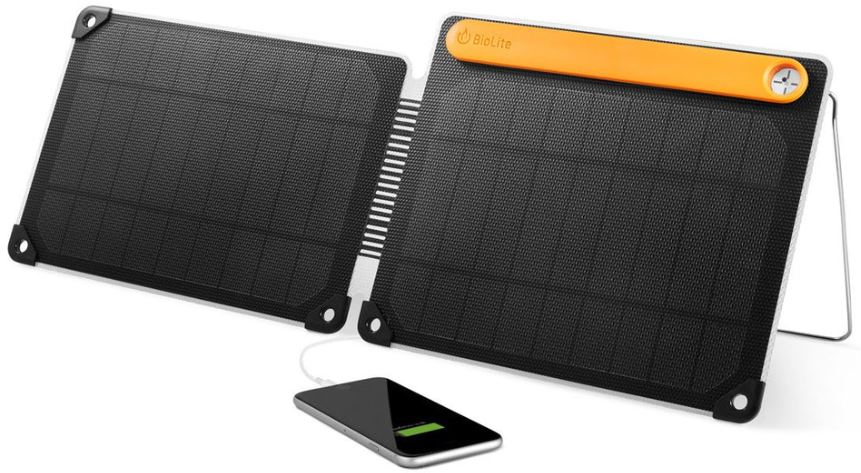
Pros:
- A solar panel that is easily transportable.
- While hiking, you can attach corner latches to your backpack and use them to charge your electronic devices.
- Perfect for individuals who enjoy outdoor activities such as camping, backpacking and hiking.
- The panel is incredibly thin, measuring only 6.6mm in depth.
- The panel surface area can be doubled by unfolding it.
- The Optimal Sun System features an integrated sundial that aligns with the sun to capture energy efficiently.
- The 360° kickstand aids in stabilizing the device on uneven surfaces.
Cons:
- Out of all the solar panels, this particular one can have the longest charging time.
- Its performance is adversely affected even by slightly cloudy weather.
- It becomes hot if it is exposed to the sun for an extended period.
- The panel does not come with a battery that is built-in or internal.
Key specs.
Weight: 550g (1.21 lbs)
Dimensions: 257 x 208 x 24 mm (10.12 x 8.19 x 0.94 in)
USB Charge Out: 10 W output to charge phones, cameras, tablets, and other gear.
Things to consider before buying your panel
Output power
Solar panels vary in power ratings, but as a general rule, larger panels produce more energy.
To make the most of their surface area while taking up minimal space during transport, camping solar panels are often designed to fold multiple times.
Packed size
If you have limited space in your vehicle and predictable weather conditions, it may be worth considering a smaller solar panel if your power needs are low.
While most people can easily set up larger solar panels at their campsite, this may not always be possible with limited space in your vehicle.
External battery
To get the most out of your camping solar panels, it’s important to pair them with a power bank.
This is because they don’t have a way to store electricity for times when there isn’t enough sunlight.
In addition, the USB ports on these panels are limited in voltage output to prevent damage to smaller electronic devices.
Therefore, it’s important that you choose a solar panel with a port that matches your power bank’s high-voltage output port.
Solar panel linking
In order to make the most of the sunny hours, campers may choose to connect several solar panels into one array to increase the amount of power collected in a battery pack.
Thin-film solar panels – not recommended for camping
Although thin-film solar panels might seem appealing due to their lightweight and flexible nature, they’re not the best choice for powering your camping gear.
They are best suited for augmenting larger solar arrays instead of powering your camping adventures.
Limitations of thin-film solar panels in a camping context
- Higher Cost: While the production costs of thin-film solar panels have decreased over time, they still tend to be more expensive than traditional monocrystalline panels. This makes them less suitable as an affordable option for campers looking to invest in renewable energy solutions.
- Lower Efficiency: Thin-film solar cells typically have a lower energy conversion rate compared to other types of solar cells like monocrystalline or polycrystalline. Reports say that they are only able to reach efficiencies between 10 and 12%, while monocrystalline ones can go up to around 20%. As a result, you’ll need more surface area on your panel setup if you opt for thin-films during your outdoor adventures.
- Lifespan Concerns: Thin-film panels tend to be more susceptible to damage and deterioration compared to their rigid counterparts. This is because they are made up of less reliable substances such as amorphous silicon or cadmium telluride rather than the sturdy crystalline silicon found in conventional solar cells. Hence, thin-film panels may not last as long on your camping trips and could require more frequent replacement..
Conclusion
When it comes to camping, having a reliable source of power is essential. From charging your phone to powering your campsite lights, solar panels have become an increasingly popular option for outdoor enthusiasts.
In this article, we’ve highlighted some of the best solar panels for camping based on their efficiency, portability, and durability.
It’s important to consider factors such as direct sunlight availability and energy conversion technology when choosing a solar panel that will work best for you during your camping trip.
FAQs
What type of solar panel is best for camping?
The best type of solar panel for camping is a portable, foldable, and lightweight design that offers efficient energy conversion. Monocrystalline panels are recommended due to their higher efficiency rates and durability. Some popular options include the Anker 625, Lion 50W Foldable Panel, Jackery SolarSaga60, and GoSun Solar Panel30.
How many watts of solar do I need for camping?
The wattage required depends on your power needs during the trip. For basic charging needs like smartphones or small devices, a 20-40W panel should suffice. However, if you plan to charge larger electronics such as laptops or power stations, consider investing in a 60-100W solar panel setup.
Are camping solar panels any good?
Camping solar panels can be highly effective when chosen correctly based on your specific requirements. They provide an eco-friendly source of electricity while promoting sustainability during outdoor adventures. Ensure that you select a high-quality product with efficient energy conversion technology to maximize its effectiveness.
Is 100W solar panel enough for camping?
A 100W solar panel may be sufficient for most campers’ electrical needs including charging phones, tablets, cameras and even some laptops or portable power stations. It’s important to assess your energy consumption before deciding on the appropriate size of the system.
